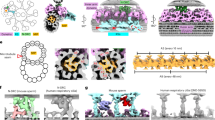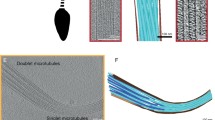Summary
Sperm of the frog lung-fluke, Haematoloechus medioplexus, were treated in various ways and their microtubules and axial units were subsequently studied in sectioned and negatively-stained material. Microtubules and axial units were generally unaffected by exposure to colchicine, cold, and KCl, although with KCl certain lateral projections from doublet tubule A appeared more prominent in negatively-stained preparations. Both mercaptoethanol and urea have a dissociative effect on doublet tubules and microtubules, with doublet tubules being the more sensitive. Pepsin-HCl initially digests the dense region associated with the A tubule of a doublet pair and the core of the axial unit. Microtubules and B tubules of doublet units are later digested; in microtubules, there appears to be a proteinaceous material in the lucent central region which is digested before disappearance of the wall of the microtubule. Further evidence is presented indicating that the characteristically helical wall of the microtubules is made up of spherical subunits about 50 Å in diameter, with about 8 subunits in one turn of the helix. Under certain conditions, the helical structure may be altered to form a wall comprised of longitudinal filaments. It is emphasized that not all microtubules are structurally and chemically equivalent, and it follows that all microtubules do not share a common function.
Similar content being viewed by others
References
Aikawa, M.: Ultrastructure of the pellicular complex of Plasmodium fallax. J. Cell Biol. 35, 103–113 (1967).
Anderson, W. A., and R. A. Ellis: Ultrastructure of Trypanosoma lewisi: flagellum, microtubules, and the kinetoplast. J. Protozool. 12, 483–499 (1965).
André, J., et J. Thiery: Mise en évidence d'une sous-structure fibrillaire dans les filaments axonématiques des flagelles. J. Microscopie 2, 71–80 (1963).
Barnicot, N. A.: A note on the structure of spindle fibres. J. Cell Sci. 1, 217–222 (1966).
Behnke, O.: The effect of colchicine and sodium cacodylate on the spindle of dividing vertebrate cells. J. Ultractruct. Res. 12, 241–242 (1965).
—: Incomplete microtubules observed in mammalian blood platelets during microtubule polymerization. J. Cell Biol. 34, 697–701 (1967).
—, and A. Forer: Evidence for four classes of microtubules in individual cells. J. Cell Sci. 2, 169–192 (1967).
—, and T. Zelander: Substructure in negatively stained microtubules of mammalian blood platelets. Exp. Cell Res. 43, 236–239 (1966).
—: Filamentous substructure of microtubules of the marginal bundle of mammalian blood platelets. J. Ultrastruct. Res. 19, 147–165 (1967).
Bennett, H. S., and J. H. Luft: s-Collidine as a basis for buffering fixatives. J. biophys. biochem. Cytol. 6, 113–114 (1959).
Bernhard, W., N. Granboulan, G. Barski, et P. Tournier: Essais cytochimie ultrastructurale. Digestion de virus sur coupes ultrafines. C. R. Soc. Biol. (Paris) 252, 202–204 (1961).
Borisy, G. G., and E. W. Taylor: The mechanism of action of colchicine. Binding of colchicine-3H to cellular protein. J. Cell Biol. 34, 525–533 (1967).
—: The mechanism of action of colchicine. Colchicine binding to sea urchin eggs and the mitotic apparatus. J. Cell Biol. 34, 535–548 (1967).
Burton, P. R.: Substructure of certain cytoplasmic microtubules: an electron microscopic study. Science 154, 903–905 (1966a).
—: A comparative electron microscopic study of cytoplasmic microtubules and axial unit tubules in a spermatozoon and a protozoan. J. Morph. 120, 397–424 (1966b).
—: Fine structure of the unique central region of the axial unit of lung-fluke spermatozoa. J. Ultrastruct. Res. 19, 166–172 (1967).
Caulfield, J. B.: Effects of varying the vehicle for OsO4 fixation. J. biophys. biochem. Cytol. 3, 827–830 (1957).
Dirksen, E. R.: The isolation and characterization of asters from artificially activated sea urchin eggs. Exp. Cell Res. 36, 256–269 (1964).
Gall, J. G.: Microtubule fine structure. J. Cell Biol. 31, 639–643 (1966).
Gibbons, I. R.: The organization of cilia and flagella. In: Molecular organization and biological function (J. M. Allen, ed.), p. 211–237. New York: Harper and Row 1967.
Glauert, A. M., and J. A. Lucy: Electron microscopy of negatively-stained lipids. Protoplasma 63, 208–211 (1967).
Grimstone, A. V., and A. Klug: Observations on the substructure of flagellar fibres. J. Cell Sci. 1, 351–362 (1966).
Kane, R. E.: The mitotic apparatus. Identification of the major soluble component of the glycol-isolated mitotic apparatus. J. Cell Biol. 32, 243–253 (1967).
Kerridge, D., R. W. Hörne, and A. M. Glauert: Structural components of flagella from Salmonella typhimurium. J. molec. Biol. 4, 227–238 (1962).
Kiefer, B., H. Sakai, A. J. Solari, and D. Mazia: The molecular unit of the microtubules of the mitotic apparatus. J. molec. Biol. 20, 75–79 (1966).
Lauffer, M. A.: Polymerization-depolymerization of tobacco mosaic virus protein. In: The molecular basis of neoplasm, p. 180. Austin: University of Texas Press 1962.
Ledbetter, M. C., and K. R. Porter: Morphology of microtubules of plant cells. Science 144, 872–874 (1964).
Lockwood, A. P. M.: “Ringer” solutions and some notes on the physiological basis of their ionic composition. Comp. Biochem. Physiol. 2, 241–289 (1961).
Lowy, J., and J. Hanson: Electron microscope studies of bacterial flagella. J. molec. Biol. 11, 293–313 (1965).
Lucy, J. A., and A. M. Glauert: Structure and assembly of macromolecular lipid complexes composed of globular micelles. J. molec. Biol. 8, 727–748 (1964).
Luft, J. H.: Improvements in epoxy resin embedding methods. J. biophys. biochem. Cytol. 9, 409–414 (1961).
Malawista, S. E., and K. G. Bensch: Human polymorphonuclear leukocytes: demonstration of microtubules and effect of colchicine. Science 156, 521–522 (1967).
Mazia, D., and K. Dan: The isolation and biochemical characterization of the mitotic apparatus of dividing cells. Proc. nat. Acad. Sci. (Wash.) 38, 826–838 (1952).
Meyer, H., and K. R. Porter: A study of Trypanosoma cruzi with the electron microscope. Parasitology 44, 16–23 (1954).
Nelson, L.: Contractile proteins of marine invertebrate spermatozoa. Biol. Bull. 130, 378–386 (1966).
Parsons, D. F.: Negative staining of thinly spread cells and associated virus. J. Cell Biol. 16, 620–626 (1963).
Pease, D. C.: The ultrastructure of flagellar fibrils. J. Cell Biol. 18, 313–326 (1963).
Peters, A., and J. E. Vaughn: Microtubules and filaments in the axons and astrocytes of early postnatal rat optic nerves. J. Cell Biol. 32, 113–119 (1967).
Phillips, D. M.: Substructure of flagellar tubules. J. Cell Biol. 31, 635–638 (1966).
Pickett-Heaps, J. D.: The effects of colchicine on the ultrastructure of dividing plant cells, xylem wall differentiation and distribution of cytoplasmic microtubules. Develop. Biol. 15, 206–236 (1967).
Porter, K. R.: Cytoplasmic microtubules and their functions. In: Principles of biomolecular organization (G. E. W. Wolstenholme and M. O'Conner, eds.), CIBA Found. Symp., 308–345. Boston: Little, Brown & Co. 1966.
Reynolds, E. S.: The use of lead citrate at high pH as an electron-opaque stain in electron microscopy. J. Cell Biol. 17, 208–212 (1963).
Ringo, D. L.: The arrangement of subunits in flagellar fibers. J. Ultrastruct. Res. 17, 266–277 (1967).
Robbins, E., and N. K. Gonatas: Histochemical and ultrastructural studies on HeLa cell cultures exposed to spindle inhibitors with special reference to the interphase cell. J. Histochem. Cytochem. 12, 704–711 (1964).
Roth, L. E.: Electron microscopy of mitosis in amebae. III. Cold and urea treatments: a basis for tests of direct effects of mitotic inhibitors on microtubule formation. J. Cell Biol. 34, 47–59 (1967).
Sabatini, D. D., K. Bensch, and R. J. Barrnett: Cytochemistry and electron microscopy. The preservation of cellular ultrastructure and enzymatic activity by aldehyde fixation. J. Cell Biol. 17, 19–58 (1963).
Sandborn, E., A. Szeberenyi, P. Messier, and P. Bois: A new membrane model derived from a study of filaments, microtubules and membranes. Rev. Canadienne Biol. 24, 243–276 (1965).
Silver, M. D., and J. E. McKinstry: Morphology of microtubules in rabbit platelets. Z. Zellforsch. 81, 12–17 (1967).
Slautterback, D. B.: Cytoplasmic microtubules. I. Hydra. J. Cell Biol. 18, 367–388 (1963).
Sleigh, M. A.: The biology of cilia and flagella. New York: Pergamon Press (MacMillan) 1962. 242 pp.
Stephens, R. E.: The mitotic apparatus. Physical chemical characterization of the 22S protein component and its subunits. J. Cell Biol. 32, 255–275 (1967).
Stevens, R. E., F. L. Renaud, and I. R. Gibbons: Guanine nucleotide associated with the protein of the outer fibers of flagella and cilia. Science 156, 1606–1608 (1967).
Taylor, E. W.: The mechanism of colchicine inhibition of mitosis. I. Kinetics of inhibition and the binding of H3-colchicine. J. Cell Biol. 25, 145–160 (1965).
Tilney, L. G.: Microtubules in the asymmetric arms of Actinosphaerium and their response to cold, colchicine, and hydrostatic pressure. Anat. Rec. 151, 426 (1965).
—, Y. Hiramoto, and D. Marsland: Studies on the microtubules in Heliozoa. III. A pressure analysis of the role of these structures in the formation and maintenance of the axopodia of Actinosphaerium nucleofilum (Barrett). J. Cell Biol. 29, 77–95 (1966).
—, and K. R. Porter: Studies on the microtubules in Heliozoa. II. The effect of low temperature on these structures in the formation and maintenance of the axopodia. J. Cell Biol. 34, 327–343 (1967).
Author information
Authors and Affiliations
Additional information
This research was supported by U.S. Public Health Service Grant AI-06448 and an institutional grant from the American Cancer Society.
Rights and permissions
About this article
Cite this article
Burton, P.R. Effects of various treatments on microtubules and axial units of lung-fluke spermatozoa. Z. Zellforsch. 87, 226–248 (1968). https://doi.org/10.1007/BF00319722
Received:
Issue Date:
DOI: https://doi.org/10.1007/BF00319722




